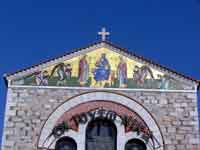- Ancient History
- Chuvin, Pierre, 1990, B. A. Archer, translator, A Chronicle of the Last Pagans
(Harvard) ISBN 0-674-12970-9
- Dodds, E. R., 1964 The Greeks and the Irrational (University of California)
- Dodds, E. R., 1965. Pagan and Christian in an Age of Anxiety: Some Aspects of the Religious Experience from Marcus Aurelius to Constantine (Cambridge)
- Jones, A.H.M., 1949. Constantine and the Conversion of Europe (Macmillan) .
- MacMullen, Ramsay, 1969. Constantine, (Dial Press)
- MacMullen, Ramsay, 1984, Christianizing the Roman Empire A.D. 100-400
, (Yale)
- MacMullen, Ramsay, 1990. Changes in the Roman Empire: Essays in the Ordinary (Princeton)
- MacMullen, Ramsay, 1966. Enemies of the Roman Order : Treason, Unrest and Alienation in the Empire
(Harvard)
- MacMullen,Ramsay, Eugene N. Lane (Editor) , Paganism and Christianity, 100-425 C.E
.: A Sourcebook (Paperback) Augsburg Fortress Publishers, 1992, ISBN: 0800626478
The Association of Ancient Historians has honored Ramsay MacMullen as being the finest ancient historian of the Roman Empire in our time. Some may find him difficult, he speaks the language of the professional scholar, but reading his works is certainly worth the time and effort - Wilken, Robert L., 1984 Christians As the Romans Saw Them (Yale)
- Eusebius of Caesarea, The Life of the blessed Emperor Constantine in 4 books from AD 306 to 337.
- Encyclopaedia Britannica 1911: Constantine
- Lactantius , (AD 240-320) Of the Manner the in Which the Persecutors Died,
- "Constantine the Great", by Charles G. Herbermann and Georg Grupp. The Catholic Encyclpedia (1908)
- "Donatists", by John Chapman. The Catholic Encyclopedia (1909)
- Sources on the Antonine Plague
- Galen, On the Natural Faculties
- Marcus Cornelius Fronto, Letters of Marcus Cornelius Fronto
- Vlassis R. Rassias,"Es Edafos Ferein", 2nd edition, Athens, 2000, ISBN 960-7748-20-4
.
Gaius Flavius Valerius Aurelius Constantinus (Latin: IMP CAESAR FLAVIVS CONSTANTINVS PIVS FELIX INVICTVS AVGVSTVS ¹) (February 27, 272–May 22, 337), commonly known as Constantine I or Constantine the Great, was proclaimed Augustus by his troops on July 25, 306 and ruled an ever-growing portion of the Roman Empire until his death. Constantine is famed for his refounding of Byzantium (modern Istanbul) as "Nova Roma" (New Rome) or Constantinople (Constantine's City). Constantine is best remembered in modern times for the Edict of Milan in 313 and the Council of Nicaea in 325, which fully legalized and then legitimized Christianity in the Empire for the first time. These actions are considered major factors in that religion's spread, and his reputation as the "first Christian Emperor" has been promulgated by historians from Lactantius and Eusebius of Caesarea to the present day.
Early life
Bronze statue of Constantine I outside York Minster, near where he was acclaimed Emperor in 306
Constantine was born at Naissus,(today's Niš, Serbia, Serbia and Montenegro) in Upper Moesia, to Constantius I Chlorus, and Flavia Iulia Helena, an innkeeper's daughter who at the time was an adolescent of only sixteen years. His father left his mother around 292 to marry Flavia Maximiana Theodora, daughter or step-daughter of the Western Roman Emperor Maximian. Theodora would give birth to six half-siblings of Constantine, including Julius Constantius.
Young Constantine served at the court of Diocletian in Nicomedia, after the appointment of his father as one of the two caesares(junior emperors) of the Tetrarchy in 293. In 305, the Augustus, Maximian, abdicated, and Constantius succeeded to the position. However, Constantius fell sick during an expedition against the Picts and Scots of Caledonia, and died on July 25, 306. Constantine managed to be at his deathbed in Eboracum (York) of Roman Britain, where the loyal general Crocus, of Alamannic descent, and the troops loyal to his father's memory proclaimed him an Augustus ("Emperor"). For the next eighteen years, he fought a series of battles and wars of consolidation that first obtained him co-rule with the Eastern Roman Emperor, and then finally leadership of a reunified Roman Empire.
Constantine and Christianity
Main article: Constantine I and Christianity
Constantine is perhaps best known for being the first Roman Emperor to freely allow Christianity. Christian historians ever since Lactantius have adhered to the view that Constantine "adopted" Christianity as a kind of replacement for the official Roman paganism. Despite the questions surrounding Constantine's Christianity, he is celebrated as a major Saint of Eastern Orthodoxy. Though he was not baptized until he was on his deathbed, his conversion, according to official Christian sources, was the immediate result of an omen before his victory in the Battle of Milvian Bridge, October 28, 312. Upon seeing this vision, Constantine is said to have instituted a new standard to be carried into battle called the labarum.
Constantine and Licinius' Edict of Milan (313) removed penalties for professing Christianity, under which many were martyred in previous persecutions of Christians, and returned confiscated Church property.
After the Edict, new avenues were opened to Christians, including the right to compete with pagan Romans in the traditional cursus honorum for high government positions, and greater acceptance into general civil society. New churches were allowed to be constructed and Christian leadership became increasingly bold — Christian bishops took aggressive public stances that were unheard of among other religions.
As a result, Church controversies, which had been lively within the Christian communities since the mid-2nd century, now flared in public schisms, often with riotous violence. Constantine saw quelling religious disorder as the divinely-appointed emperor's duty and eventually called the First Council of Nicaea (May 20 - July 25, 325) to settle some of the doctrinal problems plaguing the early church, notably Arianism.
Other segments of the populace were leery of Christians for their public refusal to make token sacrifices to the gods and the genius of the Emperor.
Persian Reaction
Beyond the limites, east of the Euphrates, the Sassanid rulers of the Persian Empire had usually tolerated their Christians. With the edicts of toleration in the Roman Empire, Christians in Persia would now be regarded as allies of Persia's ancient enemy, and were thus persecuted. A letter supposedly from Constantine to Shapur II of Persia and alleged to have been written in c. 324 urged Shapur to protect the Christians in his realm. Shapur II wrote to his generals:
You will arrest Simon, chief of the Christians. You will keep him until he signs this document and consents to collect for us a double tax and double tribute from the Christians … for we Gods have all the trials of war and they have nothing but repose and pleasure. They inhabit our territory and agree with Caesar, our enemy. (quoted in Freya Stark, Rome on the Euphrates 1967, p. 375)
Though the document called the "Donation of Constantine" was proved a forgery in the 15th century, when the stories of Constantine's conversion were long-established "facts" it was for centuries supposed to document the conversion of the Roman Empire and justify Papal primacy and temporal powers.
Constantine's Life and Actions after The Edict of Milan
Coins struck for emperors often reveal details of their personal iconography. During the early part of Constantine's rule, representations first of Mars and then (from 310) of Apollo as Sun god consistently appear on the reverse of the coinage. Mars had been associated with the Tetrarchy, and Constantine's use of this symbolism served to emphasize the legitimacy of his rule. After his breach with his father's old colleague Maximian in 309– - 310, Constantine began to claim legitimate descent from the 3rd century emperor Marcus Aurelius Claudius Gothicus, the hero of the Battle of Naissus (September, 268). The Augustan History of the 4th century reports Constantine's paternal grandmother Claudia to be a daughter of Crispus, Crispus being a reported brother of both Claudius II and Quintillus. Historians however suspect this account to be a genealogical fabrication to flatter Constantine.
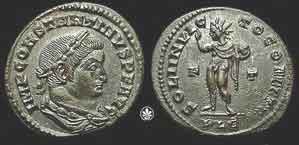
Coin of Constantine, with depiction of the sun god Sol Invictus, holding a globe and right hand raised. Legend "SOLI INVICTO COMITI". [Source]
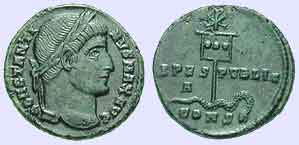
Follis by Constantine. On the reverse, a labarum with the chi-rho. [Source]
Gothicus had claimed the divine protection of Apollo-Sol Invictus. In mid-310, two years before the victory at the Milvian Bridge, Constantine reportedly experienced the publicly announced vision in which Apollo-Sol Invictus appeared to him with omens of success. Thereafter the reverses of his coinage were dominated for several years by his "companion, the unconquered Sol" — the inscriptions read SOLI INVICTO COMITI. The depiction represents Apollo with a solar halo, Helios-like, and the globe in his hands. In the 320s Constantine has a halo of his own. There are also coins depicting Apollo driving the chariot of the Sun on a shield Constantine is holding and another in 312 shows the Christian chi-rho on a helmet Constantine is wearing.
Constantine was also known for being ruthless with his political enemies, deposing the Eastern Roman Emperor Licinius, his brother-in-law, by strangulation in 325 even though he had publicly promised not to execute him upon Licinius' surrender in 324. In 326, Constantine executed first his eldest son Crispus and a few months later his own second wife Fausta. (Crispus was the only known son of Constantine by his first wife Minervina). There are rumours of step-mother and step-son having had an affair which caused Constantine's jealousy. The rumours were reported however by 5th century historian Zosimus and 12th century historian Joannes Zonaras. Their sources are not stated.
Family influence is thought to account for a personal adoption of Christianity: Helena is said to be "probably born a Christian" though virtually nothing is known of her background, save that her mother was the daughter of an innkeeper and her father a successful soldier, a career that excluded overt Christians. Helena became known later in life for numerous pilgrimages.
Constantine, following a widespread custom, was not baptized until close to his death in 337, when his choice fell upon the Arian bishop Eusebius of Nicomedia, who happened, despite his being an ally of Arius, to still be the bishop of the region. Also, Eusebius was a close friend of Constantine's sister; she probably secured his recall from exile.
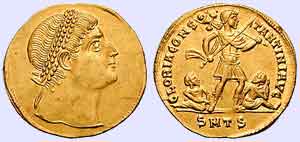
Staring eyes on later Constantine coinage. [Source]
The great staring eyes in the iconography of Constantine, though not specifically Christian, show how official images were moving away from early imperial conventions of realistic portrayal towards schematic representations: the Emperor as Emperor, not merely as this particular individual Constantine, with his characteristic broad jaw and cleft chin. The large staring eyes will loom larger as the 4th century progresses: compare the early 5th century silver coinage of Theodosius I.
Buy Fine Art Prints | Greeting Cards | iPhone Cases | Tote Bags | Clothing | ...
Later Life
His victory in 312 over Maxentius at the Battle of Milvian Bridge resulted in his becoming Western Augustus, or ruler of the entire Western Roman Empire. He gradually consolidated his military superiority over his rivals in the crumbling Tetrarchy.
In the year 320, Licinius, emperor of the Eastern Roman Empire, reneged on the religious freedom promised by the Edict of Milan in 313 and began another persecution of the Christians. This was a puzzling inconsistency since Constantia, half-sister of Constantine and wife of Licinius, was an influential Christian. It became a challenge to Constantine in the west, climaxing in the great civil war of 324. The armies were so large another like these would not be seen again until at least the 14th century. Licinius, aided by Goth mercenaries, represented the past and the ancient faith of Paganism. Constantine and his Franks marched under the Christian standard of the labarum, and both sides saw the battle in religious terms. Supposedly outnumbered, but fired by their zeal, Constantine's army emerged victorious. He was the sole emperor of the entire Roman Empire. (MacMullen 1969)
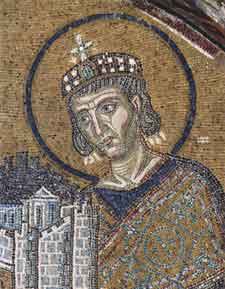
Constantine the Great
(mosaic in Hagia Sophia, Constantinople, c. 1000) [Source]
This battle represented the passing of old Rome, and the beginnings of the Eastern Empire as a center of learning, prosperity, and cultural preservation. Constantine rebuilt the city of Byzantium which was said to have been founded by colonists from the Greek city of Megara under Byzas in 667 BC. He renamed the city Nova Roma (New Rome), providing it with a Senate and civic offices similar to the older Rome, and the new city was protected by the alleged True Cross, the Rod of Moses and other holy relics. The figures of old gods were replaced and often assimilated into Christian symbolism. On the site of a temple to Aphrodite was built the new Basilica of the Apostles. Generations later there was the story that a Divine vision lead Constantine to this spot, and an angel no one else could see, led him on a circuit of the new walls. After his death it was renamed Constantinopolis (or Constantinople, "Constantine's City"), and gradually became the capital of the empire. (MacMullen 1969)
Constantine also passed laws making the occupations of butcher and baker hereditary, and more importantly, supported converting the coloni (tenant farmers) into serfs — laying the foundation for European society during the Middle Ages.
In his later life he even turned to preaching, giving his own sermons in the palace before his court and invited crowds. His sermons preached harmony at first, but gradually turned more confrontational with the old pagan ways. The reason for this later "change of heart" remains conjectural. However, pagans still received appointments, even up to the end of his life. Exerting his absolute power, the army recited his composed Latin prayer in an attempt to convert them to Christianity, which failed. He began a large building program of churches in the Holy Land, which while greatly expanding the faith also allowed considerable increase in the power and wealth (and as such the corruption) of the clergy, as the clergy took over many aspects of government, including the courts and civil cases.
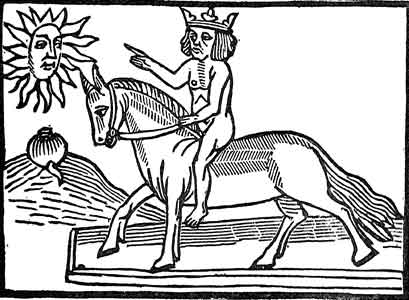
15th century drawing of Constantine I
Constantine's Legal Standards
Constantine's laws in many ways improved those of his predecessors, though they also reflect his more violent age. Some examples:
- For the first time, girls could not be abducted.
- A punishment of death was mandated to anyone collecting taxes over the authorized amount.
- A prisoner was no longer to be kept in total darkness, but must be given the outdoors and daylight.
- A condemned man was allowed to die in the arena, but he could not be branded on his "heavenly beautifed" face, just on the feet.
- Parents caught allowing their daughters to be seduced were to have molten lead poured down their throats.
- Gladiatorial games were ordered to be eliminated in 325, although this had little real effect.
- A slave master's rights were limited, but a slave could still be beaten to death.
- Crucifixion was abolished for reasons of Christian piety, but was replaced with hanging, to show there was Roman law and justice.
- Easter could be publicly celebrated.
- Sunday was declared a day of rest, on which markets were banned and public offices were closed (except for the purpose of freeing slaves). There were however no restrictions on farming work.
(MacMullen 1969, New Catholic Encyclopedia 1908)
Constantine's Courts and Appointees
Constantine respected cultivation and Christianity, and his court was composed of older, respected, and honored men. Leading Roman families that refused Christianity were denied positions of power, yet two-thirds of his top government was non-Christian. (MacMullen 1969,1984, New Catholic Encyclopedia 1908)
"From Pagan temples Constantine had his statue removed. The repair of Pagan temples that had decayed was forbidden. These funds were given to the favored Christian clergy. Offensive forms of worship, either Christian or Pagan, were suppressed. At the dedication of Constantinople in 330 a ceremony half Pagan and half Christian was performed, in the market place, the Cross of Christ was placed over the head of the Sun-God's chariot. There was a singing of hymns." (New Catholic Encyclopedia 1908)
Constantine's Legacy
Although he earned his honorific of "The Great" from Christian historians long after he had died, he could have claimed the title on his military achievements alone. In addition to reuniting the empire under one emperor, Constantine won major victories over the Franks and Alamanni (306–-308), the Franks again (313-–314), the Visigoths in 332 and the Sarmatians in 334. In fact, by 336, Constantine had actually reoccupied most of the long-lost province of Dacia, which Aurelian had been forced to abandon in 271. At the time of his death, he was planning a great expedition to put an end to raids on the eastern provinces from the Persian Empire.
He was succeeded by his three sons by Fausta, Constantine II, Constantius II and Constans, who secured their hold on the empire with the murder of a number of relatives and supporters of Constantine. The last member of his dynasty was his nephew and son-in-law, Julian, who attempted to restore paganism.
Geoffrey of Monmouth and a Constantine made British
The English chronicler Geoffrey of Monmouth offered a genealogy of British kings that linked them to the Fall of Troy at the end of the Trojan War. His Historia Regum Britanniae (written ca. 1136 during the reign of Stephen of England) is not considered a reliable source by modern historians.
Geoffrey claimed that Helena, Constantine's mother, was actually the daughter of "King Cole", the mythical King of the Britons and eponymous founder of Colchester. A daughter for King Cole had not previously figured in the lore, at least not as it has survived in writing, and this pedigree is likely to reflect Geoffrey's desire to create a continuous line of regal descent. It was indecorous, Geoffrey considered, that a king might have less-than-noble ancestors. Monmouth also said that Constantine was proclaimed "King of the Britons" at York, rather than Roman Emperor.
Notes
1- In the English language, Constantine's official Imperial title is Imperator Caesar Flavius Constantine Augustus, the blessed, the lucky, the unconquerable. After 312, he added maximus ("the greatest"), and after 325 replaced invictus ("unconquerable") with victor, as invictus reminded of Sol Invictus, the Sun God.
See also
- Constantine I and Christianity
- Donation of Constantine
- Arch of Constantine, triumphal arch to the victory at Milvian Bridge.
- Donatist
- Ammianus Marcellinus

Links
| Preceded by: Constantius I |
Roman Emperor 306-337 with Galerius, Licinius |
Succeeded by: Constantius II, Constantine II and Constans |
| Mythical British Kings |
Succeeded by: Octavius |
Buy Fine Art Prints | Greeting Cards | iPhone Cases | Tote Bags | Clothing | ...
| Ancient Greece
Science, Technology , Medicine , Warfare, , Biographies , Life , Cities/Places/Maps , Arts , Literature , Philosophy ,Olympics, Mythology , History , Images Medieval Greece / Byzantine Empire Science, Technology, Arts, , Warfare , Literature, Biographies, Icons, History Modern Greece Cities, Islands, Regions, Fauna/Flora ,Biographies , History , Warfare, Science/Technology, Literature, Music , Arts , Film/Actors , Sport , Fashion --- |
Retrieved from "http://en.wikipedia.org"
All text is available under the terms of the GNU Free Documentation License



